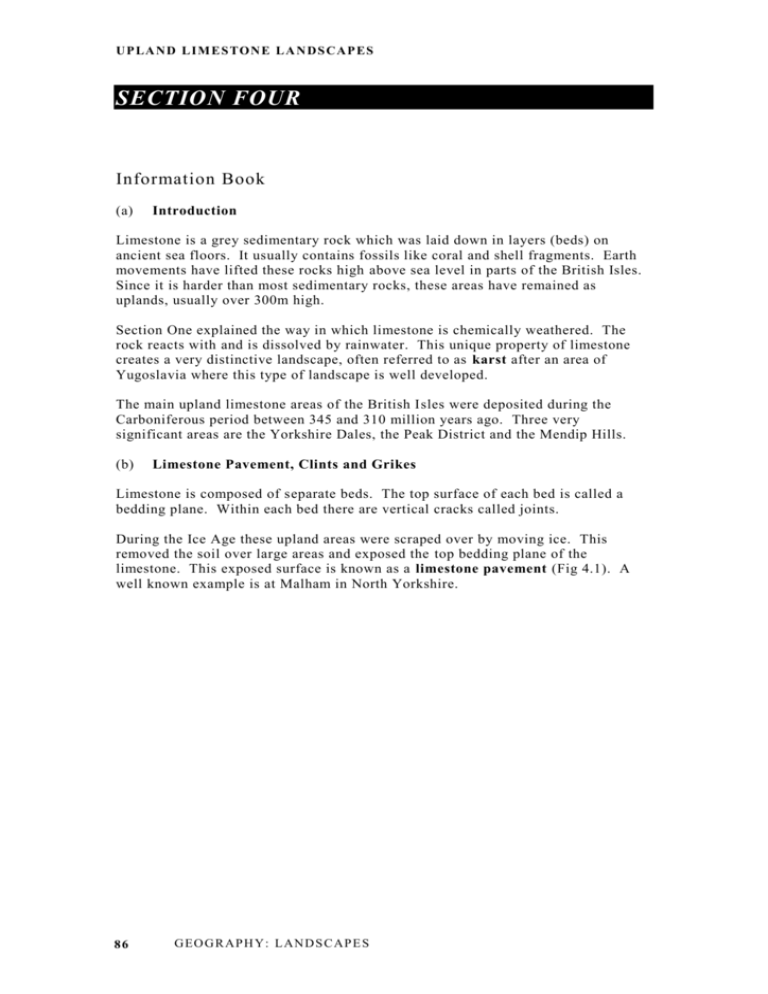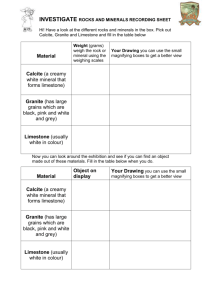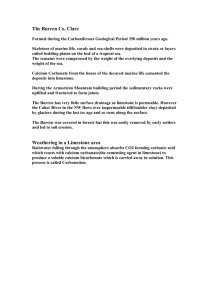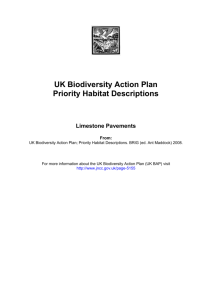
UP LA ND L IM E S TO N E L A N DS CA P ES
SECTION FOUR
Information Book
(a)
Introduction
Limestone is a grey sedimentary rock which was laid down in layers (beds) on
ancient sea floors. It usually contains fossils like coral and shell fragments. Earth
movements have lifted these rocks high above sea level in parts of the British Isles.
Since it is harder than most sedimentary rocks, these areas have remained as
uplands, usually over 300m high.
Section One explained the way in which limestone is chemically weathered. The
rock reacts with and is dissolved by rainwater. This unique property of limestone
creates a very distinctive landscape, often referred to as karst after an area of
Yugoslavia where this type of landscape is well developed.
The main upland limestone areas of the British Isles were deposited during the
Carboniferous period between 345 and 310 million years ago. Three very
significant areas are the Yorkshire Dales, the Peak District and the Mendip Hills.
(b)
Limestone Pavement, Clints and Grikes
Limestone is composed of separate beds. The top surface of each bed is called a
bedding plane. Within each bed there are vertical cracks called joints.
During the Ice Age these upland areas were scraped over by moving ice. This
removed the soil over large areas and exposed the top bedding plane of the
limestone. This exposed surface is known as a limestone pavement (Fig 4.1). A
well known example is at Malham in North Yorkshire.
86
GEO G R AP H Y: LAND S C AP E S
UP LA ND L IM E S TO N E L AN DS CA P ES
Fig 4.1: Limestone pavement
On 1:25,000 OS maps pavements can be identified by rock outcrop sy mbols on high,
flat or gently sloping land.
Rainwater will tend to soak into the vertical joints on the pavement and dissolve the
limestone. Consequently the joints become widened into grooves called grikes (Fig
4.2). The small blocks of limestone left standing between the grikes are called
clints (Fig 4.2).
Fig 4.2: Formation of clints and grikes
(c)
Swallow Holes and Intermittent Drainage
Where the joints have been considerably enlarged by solution, water can seep
downwards. A rock such as limestone which allows water to pass through it is said
to be permeable. A rock which does not let water through is impermeable.
GEO G R AP H Y: LAND S C AP E S
87
UP LA ND L IM E S TO N E L AN DS CA P ES
When a stream flows onto limestone it enlarges the joints over which it flows.
Eventually, when a joint has been enlarged sufficiently the stream will disappear
underground and flow down potholes and along underground channels, which have
been formed by water dissolving the limestone along joints and bedding planes (Fig
4.3). The stream also erodes the channels by the usual process of river erosion (see
Section One). A popular sport in limestone country is potholing where people climb
down and explore these underground passages.
Fig 4.3: Formation of a swallow hole
The point at which a stream disappears underground is called a swallow hole, for
example Gaping Ghyll on Ingleborough in the Pennines.
The underground stream will work its way down through the limestone until it
reaches an impermeable rock, over which it flows until it re -emerges at the surface
(Fig 4.4).
Fig 4.4: Cross-section showing the course of Fell Beck on the south -east slopes of
Ingleborough
88
GEO G R AP H Y: LAND S C AP E S
UP LA ND L IM E S TO N E L AN DS CA P ES
Thus, on an OS map there will be very few streams marked on parts of the map
where the rock is limestone. Where there is a mixture of limestone and
impermeable rocks, streams will disappear and then re-appear – intermittent
drainage.
(d)
Caverns
Where underground rivers are particularly effective in weathering and eroding the
limestone, caves will form. These can be enlarged into large caverns if the roof of
the cave collapses (Fig 4.5).
Fig 4.5
s wa l l o w h o l e
c a ve r n
c a ve
(e)
collapsed blocks on
c a ve r n f l o o r
Gorges
A gorge is a deep, steep-sided narrow valley. One theory for the formation of
gorges in limestone areas is that the rocks above a series of caves and caverns have
collapsed to produce a gorge (Fig 4.6). Cheddar Gorge in the Mendip Hills is a well
known example. Because limestone is permeable there is not much freeze -thaw
action on the sides of the gorge, so they remain steep.
Fig 4.6: Formation of a gorge
Stage 1
Impermeable rock
surface
Stage 2
gorge
c a ve
roof collapsed
GEO G R AP H Y: LAND S C AP E S
89
UP LA ND L IM E S TO N E L AN DS CA P ES
(f)
Stalactites and Stalagmites
A stalactite is an icicle-shaped piece of limestone hanging from the ceiling of a
cave.
A stalagmite is a stumpy column of limestone sticking up from the floor of a cave.
The water that seeps down through the limestone is heavily loaded with dissolved
lime. Where the water drips from a cave roof a small amount of water will
evaporate and leave a tiny deposit of lime. This is repeated every time water drips
from the roof, so that in time the lime deposits grow down to form a stalactite (Fig
4.7).
In a similar way lime is deposited on the floor of the cave where the drips land and
these deposits build up to form a stalagmite. The splash spreads the lime so that
stalagmites are thicker than stalactites (Fig 4.7).
Fig 4.7: Formation of stalactites and stalagmites
90
GEO G R AP H Y: LAND S C AP E S
UP LA ND L IM E S TO N E L AN DS CA P ES
Activity Sheets
Outcomes
Intermediate 1 and Intermediate 2
Knowledge and Understanding
Distribution of Upland Limestone areas in the British Isles.
Characteristics, formation and named examples of the following landscapes features:
pavements; swallow holes; caverns; stalactites; stalagmites; gorges.
GMTs
Identify examples of the above features from photographs, sketches, diagrams and
OS maps.
Draw annotated sketches from slides or photographs.
Intermediate 2
As above plus landscape features:
clint, gryke, intermittent drainage.
GEO G R AP H Y: LAND S C AP E S
91
UP LA ND L IM E S TO N E L AN DS CA P ES
Information Book Section 4 (a): Introduction
1.
Describe the appearance of limestone.
2.
Name two fossils often found in limestone.
3.
Limestone was originally deposited on the sea bed. Why does it now form
hilly areas in parts of the British Isles?
4.
What property of limestone gives it such distinctive landscape features?
5.
What name is often given to limestone landscapes?
6.
How old are the limestone rocks which make up the upland limeston e areas of
the British Isles?
7.
The map (Fig Q7) shows the outcrop of Carboniferous limestone in the British
Isles. The numbered areas show scenically important uplands. With the help
of an atlas match the numbers to the following areas:
the Burren in Western Ireland
Mendip Hills
Pennines
North Wales
Brecon
Yorkshire Dales
Peak District
Checkpoint 1
Answers
1–7
92
GEO G R AP H Y: LAND S C AP E S
UP LA ND L IM E S TO N E L AN DS CA P ES
Fig Q7: Carboniferous limestone areas in the British Isles
Section 4 (b): Limestone Pavement, Clints and Grikes
8.
What is a limestone pavement?
9.
Why is there no soil on the pavement?
10.
What are clints?
11.
What are grikes?
12.
Using an annotated diagram explain how clints and grikes are formed.
GEO G R AP H Y: LAND S C AP E S
93
UP LA ND L IM E S TO N E L AN DS CA P ES
13.
Look at Fig Q13 (or a slide). Draw a sketch and label it to show: limestone
pavement; clint; grike.
Fig Q13: Malham, Yorkshire Dales
Photo: British Geological Survey, © NERC. All rights reserved.
Checkpoint 2
Answers
8–11
Answers
12, 13
Section 4 (c): Swallow Holes and Intermittent Drainage
14.
What word is used to describe a rock which allows water to pass through it?
15.
What word describes a rock which does not allow water to pass through it?
16.
Which of these two words applies to limestone?
17.
Describe the process by which underground channels and pot-holes are formed
in limestone.
94
GEO G R AP H Y: LAND S C AP E S
UP LA ND L IM E S TO N E L AN DS CA P ES
18.
What is a swallow hole?
19.
Name an example of a swallow hole in the British Isles.
20.
What term is used to describe a drainage pattern where streams disappear at
the surface and then re-appear farther downstream?
21.
Fig 4.4. shows the course of the stream Fell Beck.
(a)
(b)
Why does it disappear?
Why does it re-emerge at the surface?
Section 4 (d): Caverns
22.
Explain how a cavern is formed.
Section 4 (e): Gorges
23.
What is a gorge?
24.
25.
Describe how a gorge may be formed in limestone areas.
Name an example of a gorge in a limestone area.
Checkpoint 3
Answers
14–21,
23, 25
Answers
22, 24
Section 4 (f): Stalactites and Stalagmites
26.
Describe the appearance of a stalactite.
27.
Describe the appearance of a stalagmite.
28.
With the aid of an annotated diagram describe how stalactites and stalagmites
are formed.
GEO G R AP H Y: LAND S C AP E S
95
UP LA ND L IM E S TO N E L AN DS CA P ES
29.
30.
Look at Fig Q29.
(a)
Draw a sketch and
it to show a
stalactite and a
stalagmite.
(b)
In what sporting
activity is the man
the picture
engaged?
label
in
Look at the block diagram (Fig Q30). Match the numbers to the following
features:
cavern
swallow hole
beds of limestone
limestone pavement
re-emerging stream
gorge
impermeable rock
Fig Q30
3
1
5
6
2
96
4
GEO G R AP H Y: LAND S C AP E S
7
UP LA ND L IM E S TO N E L AN DS CA P ES
31.
Look at Fig Q31 on the next page.
Match the numbers 1 to 5 to the following landscape features:
re-emerging stream; swallow hole; limestone beds; pavement; gorge.
GEO G R AP H Y: LAND S C AP E S
97
UP LA ND L IM E S TO N E L AN DS CA P ES
98
GEO G R AP H Y: LAND S C AP E S
UP LA ND L IM E S TO N E L AN DS CA P ES
Checkpoint 4
Answers
26, 27
30, 31
Answers
28, 29
OS Map Extract 1:25,000 Malham
32.
Match the grid references on the right to the correct landscape features on the
left.
swallow hole
limestone pavement
re-emerging stream
gorge
915643
903646
894657
897642
OS Map Extract No 1056/OLM2 1:25,000 Ingleton
33.
Look at grid square 6977.
What evidence is there that this area is limestone?
34.
Look at grid square 7176.
The NW half of this square contains symbols for rock outcrop. What feature is
this? (Hint – look at contours to establish steepness of slope.)
Checkpoint 5
Answers
32–34
GEO G R AP H Y: LAND S C AP E S
99
UP LA ND L IM E S TO N E L AN DS CA P ES
Extension exercises
OS Project Map 1:50,000 Wensleydale
E1.
Look at grid square 9891.
Give two pieces of evidence that the underlying rock is limestone.
E2.
Look at the grid squares below
9993
9095
9494
8683
Which two squares contain limestone? Explain your answer.
E3.
At which of the grid references below is there a swallow hole?
878826
E4.
958858
009958
986817
Using resources provided by your teacher find out how the fol lowing
features are formed:
scars; dry valleys; shake holes.
Checkpoint 6
Answers
E1–E3
100
GEO G R AP H Y: LAND S C AP E S
Answer
E4









